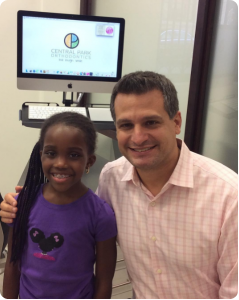Early Interceptive Orthodontic Treatment On The Upper West Side
 Many parents already know that adolescence is the most common time to wear braces and have orthodontic treatment. They may even have started a savings account or begun to prepare in other ways for their child to start braces and orthodontic treatment around age 11 or 12.
Many parents already know that adolescence is the most common time to wear braces and have orthodontic treatment. They may even have started a savings account or begun to prepare in other ways for their child to start braces and orthodontic treatment around age 11 or 12.
Unfortunately, many parents don’t realize that their child should actually see an orthodontist far earlier than that. In fact, the American Association of Orthodontists recommends that every child be evaluated by an orthodontist around age 7.
Why Should Every Child See Their Upper West Side Orthodontist?
Many orthodontic problems can benefit from early treatment (in the late elementary school years). Certain types of bite problems are more easily corrected in this age group. At this age, we can also guide the growth of the jaw and facial bones more easily in order to create enough room for all of the teeth. Additionally, protruding front teeth have a higher risk of being damaged during normal childhood play; braces can help to guide the teeth into the correct position, reducing the risk of permanent damage to these critically important teeth.
Many childhood habits, like thumb sucking and tongue pushing, can influence the development of the child’s smile as well. An orthodontist’s guidance can empower parents and children to change these habits and thus develop a better smile in the future.
What Types Of Early Orthodontic Treatment Are Used?
In some cases, braces are placed during early treatment, most commonly on the front teeth (which are permanent teeth by this age). This can help to correct bite problems or protrusion of the teeth. Addressing issues like this early can also help to boost a child’s self-confidence, since he or she will subsequently get to enter the sensitive early adolescent years with a radiant smile.
In some cases, braces may also be used on the deciduous teeth (the “baby teeth”) to create a healthy alignment of the spaces for the permanent teeth. This way, when the permanent teeth do erupt, we can anticipate that they will follow the same pattern.
Dentofacial orthopedics is also commonly used in this age group. One example of this type of treatment is the use of a palatal expander (“palate expander”), designed to influence the growth of the upper jaw. Reverse pull headgear may also be used. This type of headgear rests on the chin and forehead and pulls the upper jaw forward into a better position.
Will My Child Need Later Orthodontic Treatment, Too?
 Early interceptive treatment is generally not the only phase of orthodontic treatment. Rather, the goals are to make later treatment faster and to optimize the final result. To achieve the optimal final result, a second phase of treatment is done during adolescence. This consists of braces (or, in some cases, Invisalign). Because of the early treatment, the adolescent phase of treatment is shorter for many patients, and the final results are better.
Early interceptive treatment is generally not the only phase of orthodontic treatment. Rather, the goals are to make later treatment faster and to optimize the final result. To achieve the optimal final result, a second phase of treatment is done during adolescence. This consists of braces (or, in some cases, Invisalign). Because of the early treatment, the adolescent phase of treatment is shorter for many patients, and the final results are better.
5-Star Orthodontic Care With Your Upper West Side Orthodontist
If your child is age 7 or older, then he or she needs an evaluation by our Upper West Side orthodontist to determine whether early interceptive treatment would be beneficial. Dr. George Pliakas is the best choice for an orthodontist on the Upper West Side. Having trained in some of the top programs in the country, Dr. Pliakas specializes in both orthodontics and dentofacial orthopedics, allowing him to provide your child with all modes of treatment to achieve the ideal result.
To ensure that your child receives the best orthodontic care and feels most at ease throughout his or her treatment, you should also seek out an Upper West Side (NYC) orthodontist who is experienced in early life treatment. Dr. Pliakas has treated patients of all ages and takes particular care to put his youngest patients at their ease.
Don’t miss the window for optimal treatment of your child’s smile. Call our office or book your appointment online, so you can get a professional evaluation for your child.


















